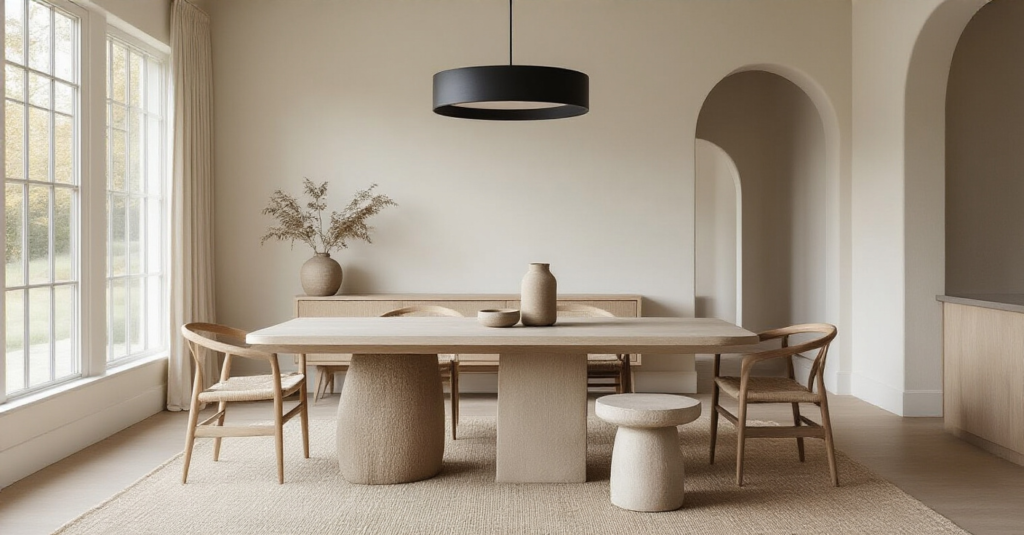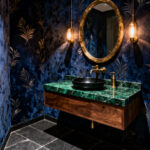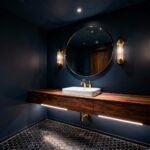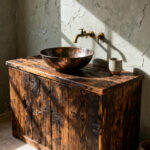You know what people always ask me? “Carley, my dining room feels so… formal. We only use it for Thanksgiving. How do I make it a room we actually want to be in all year round?” I hear this all the time, and it’s my absolute favorite challenge. Because your dining room shouldn’t be a museum piece roped off for special occasions! It’s the heart of the home, the backdrop for everything from weeknight takeout and homework marathons to buzzy dinner parties and cozy holiday feasts.
The secret isn’t about a gut renovation for every season. Please, who has the time? The secret is creating a smart, beautiful, adaptable foundation that you can easily tweak to celebrate the rhythm of the year. Think of your dining room as your favorite black dress—with the right accessories, it works for any event. Let’s ditch the stuffy and create a space that’s all about connection, joy, and making memories.
Laying the Foundation: Core Modern Design Principles
Before we get to the fun stuff—the sparkle, the drama, the color!—we have to nail the foundation. I know, I know, it sounds boring, but trust me on this. Getting this part right is what makes all those seasonal updates feel effortless instead of overwhelming. This is the canvas. Let’s make it a great one.
1. Embrace a Sophisticated Neutral Palette for Serene Ambiance
Forget “boring beige.” When I say neutrals, I’m talking about a warm, cozy backdrop that lets your seasonal decor truly pop. Think about a creamy, soulful off-white, a deep and moody charcoal gray, or a soft, earthy greige. This is your secret weapon. That vibrant green garland at Christmas? It sings against a dark gray wall. Those pretty pastel napkins for your Easter brunch? They look stunning against a warm white.
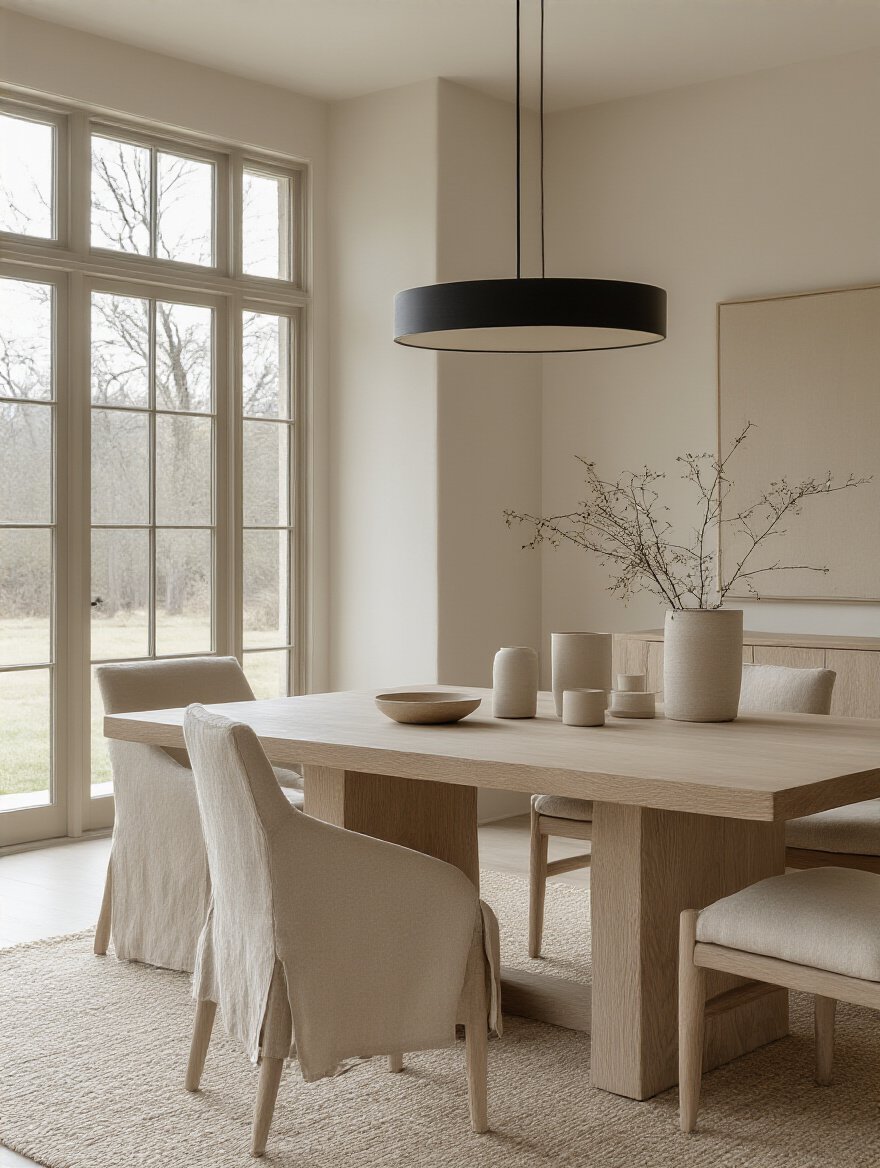
A client of mine was terrified to paint her dining room a dark, inky blue. She thought it would feel like a cave. But I promised her it would be magic. The first time she decorated for fall, with all the warm brass, rich oranges, and flickering candles, she called me just to say, “You were right. It’s the coziest room in the house.” Your walls are the supporting cast; they’re there to make your seasonal decor the star of the show.
With a perfect backdrop in place, we can now edit the space to let it breathe.
2. Achieve Sleek, Uncluttered Modernity with a Minimalist Approach
Okay, let’s clear something up. Minimalism isn’t about living in an empty, sterile white box. Not in my book, anyway! It’s simply about editing. It’s about clearing out the noise so you can make room for what really matters—life. It means that after the plates are cleared and the crumbs are wiped away, the room itself feels calm and beautiful.
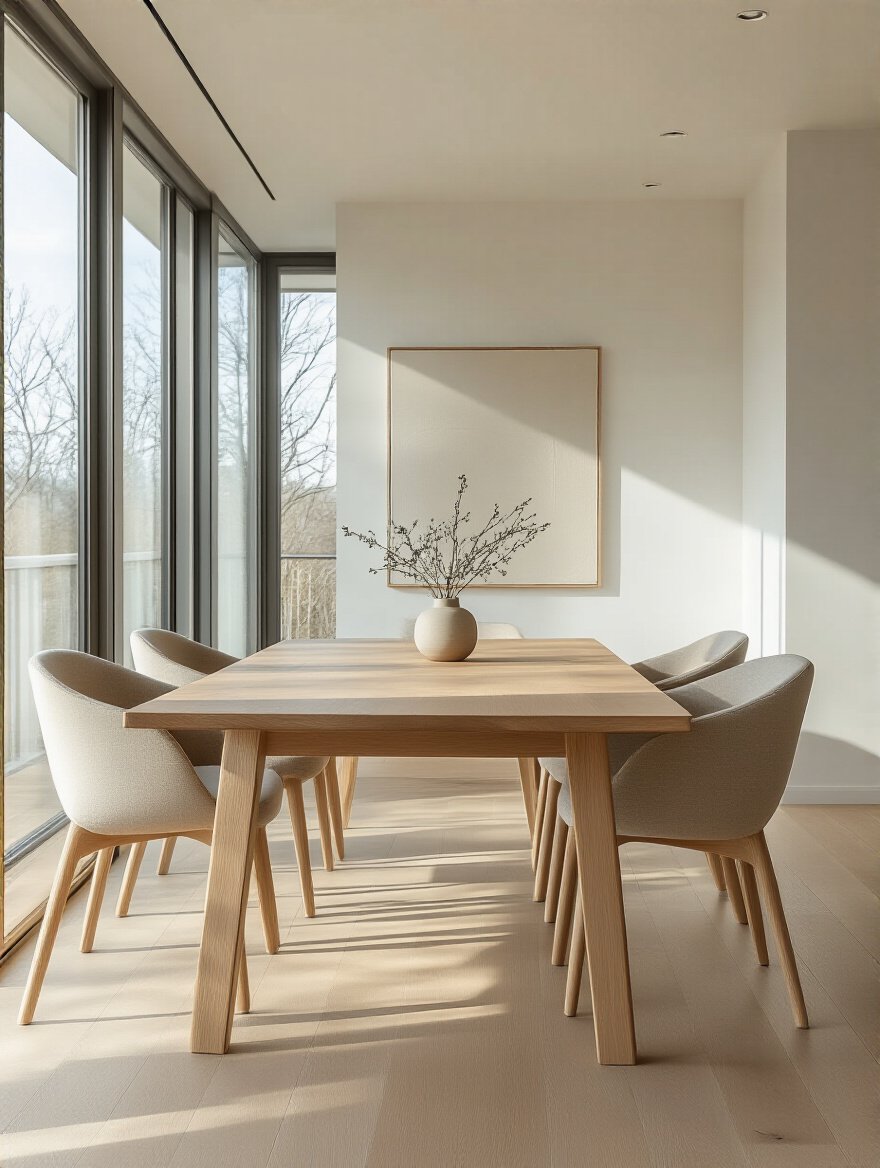
The biggest BS people say about minimalism is that it’s cold. The truth? Intentional clutter-clearing is the warmest, most welcoming thing you can do. It gives your favorite things—that gorgeous vase, the painting your kid made, that stunning light fixture—the space to actually be seen and appreciated. It’s a game-changer for busy families because a simple room is an easy room to reset at the end of a chaotic day.
Now that the room is feeling calm and curated, let’s give it some definition.
3. Define Dining Zones within Open Concepts Using Smart Layout
If you have an open-concept layout, this one’s for you. You don’t want your dining table just floating in a sea of space between the kitchen island and the sofa. You want it to feel like a destination, an intentional spot for gathering. How do you do that without building walls? With a rug. A rug is your magic trick for creating a room within a room.
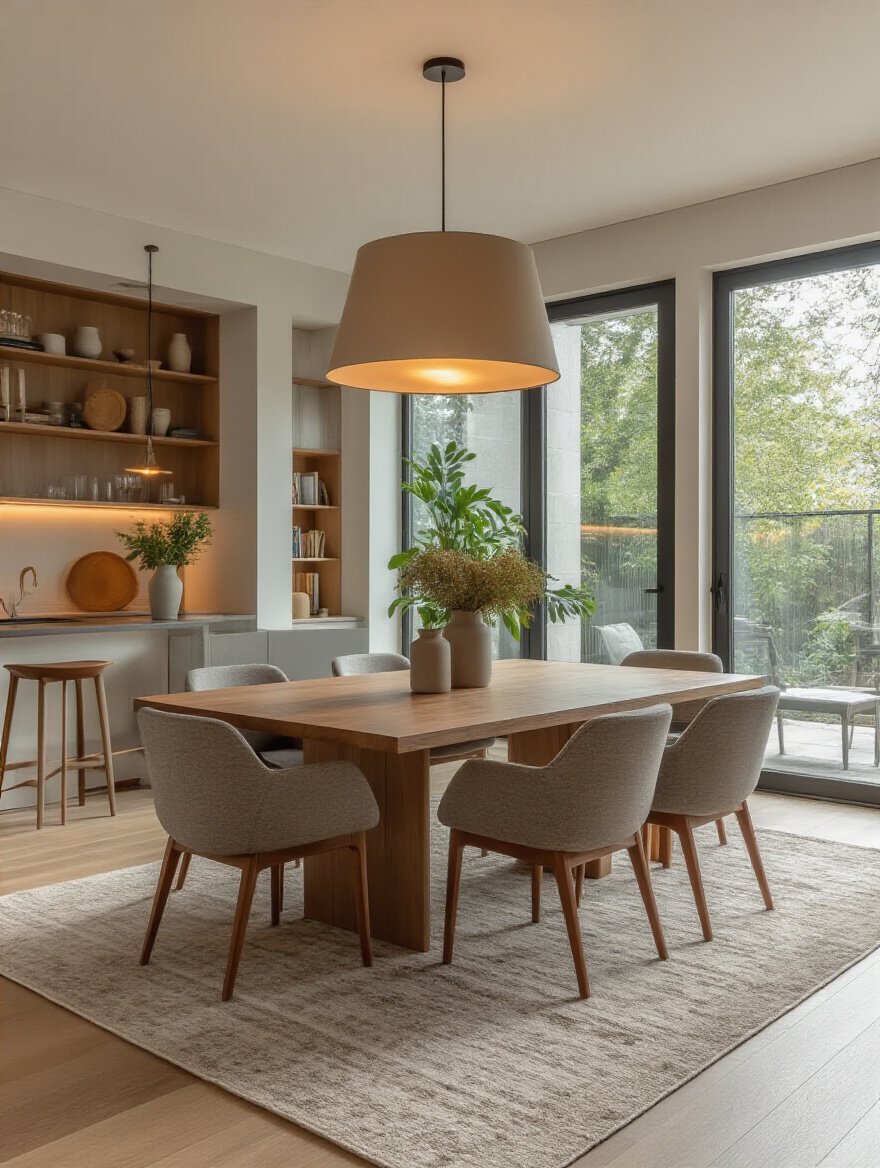
An area rug acts like a visual anchor. It’s a stage for your dining set that says, “Over here! This is where the magic happens.” I once worked on a huge loft space where the dining area just felt lost. We didn’t change a single piece of furniture; we just added a huge, textured rug underneath the table and chairs, and suddenly, the whole zone felt grounded and intimate. It’s instant architecture.
A well-defined space is a beautiful start, but it’s what you put in it that gives it soul.
4. Incorporate Eco-Conscious Materials for Sustainable Style
This isn’t about being preachy; it’s about choosing pieces with a story and a soul. A reclaimed wood table that shows the history of its past life has so much more character than a generic flat-pack piece. Thinking about sustainability means you’re curating a home with intention—surrounding yourself with materials like solid wood, real stone, and natural fibers that feel good to the touch.

There’s a warmth and authenticity you get from materials that are real and responsibly sourced. It makes your home healthier by reducing weird chemicals and glues, and it just feels better. You’re not just buying a table; you’re investing in craftsmanship and bringing a piece of nature indoors, which is a design move that never, ever goes out of style.
And speaking of investing, you want those beautiful pieces to last.
5. Select Hardwearing Surfaces for Lasting Elegance and Easy Care
My event-planning brain is taking over for a second. Let’s get real: life is messy. Kids spill juice, red wine gets splashed, and guests are not always gentle. The last thing you want is a dining table so precious you’re scared to use it. A truly modern dining room is a usable dining room.

Choosing surfaces that can take a beating—like quartz, a sealed wood, or a tough sintered stone—is a gift you give your future self. It means you can actually relax and enjoy your own party instead of following people around with coasters. I’ll always tell clients to splurge on the durable tabletop. It’s the difference between a room that looks good in a photo and a room that works for your real life.
Mastering the Essentials: Furniture & Layout for Functionality
Okay, our gorgeous canvas is prepped! Now we bring in the main characters: the furniture. This isn’t just about what looks good; it’s about making your room work brilliantly for your family, whether it’s just the two of you or the entire extended clan.
6. Optimize Dining Space with a Versatile Extendable Table
If you entertain at all—even just a couple of times a year—an extendable table is the single most valuable player in your dining room. It’s my number one must-have. For everyday life, it stays compact and cozy, giving you more floor space to move around. But then—boom!—company’s coming, and it stretches out, ready for a feast.

It’s the ultimate problem-solver. No more hauling a rickety card table up from the basement for the kids’ table. It’s one table that can do it all, adapting perfectly to the seasons of your life. This is the definition of smart, modern design: furniture that works as hard as you do.
With a flexible table in place, let’s get creative with the seating.
7. Introduce Dynamic Seating with a Mix of Chairs and Benches
Can we please bust the myth that you need a perfectly matched set of six identical chairs? Says who?! Mixing it up is where the personality comes in. One of my favorite, most stylish tricks is to use chairs on one side of the table and a long bench on the other. It immediately makes the space feel more relaxed, casual, and interesting.
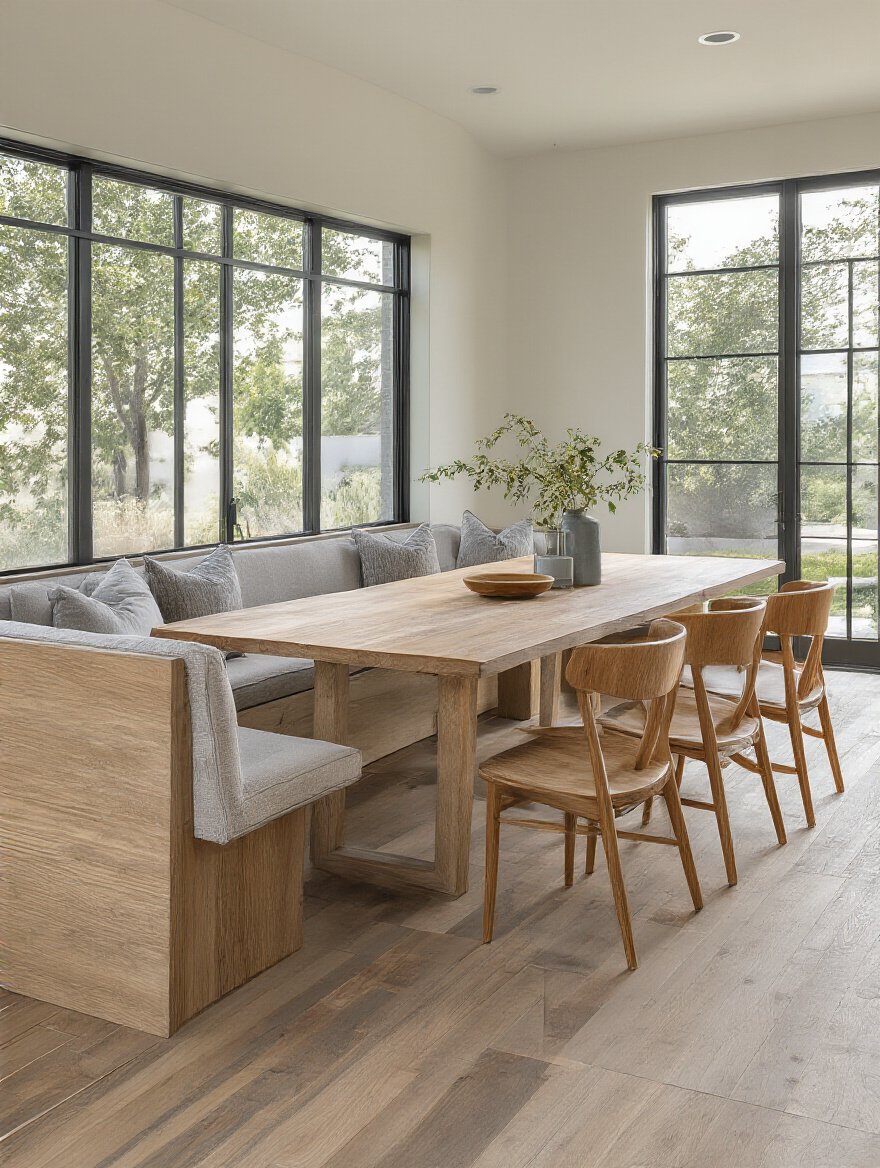
A bench is fantastic because you can always squeeze in one more person (especially kids!), and when you tuck it under the table, it saves a ton of visual and physical space. I love pairing a rustic wooden bench with sleek, modern upholstered chairs. The contrast is gorgeous. It tells people your home isn’t a showroom; it’s a place for real, relaxed living.
Now, about those chairs… let’s make them ridiculously comfortable.
8. Prioritize Guest Comfort with Plush Upholstered Dining Chairs
Confession time: I used to think hard, minimalist wooden chairs were the epitome of chic. Then I actually sat through a three-hour dinner party on one and could barely walk afterward. Never again. Upholstered dining chairs are a non-negotiable for me now. They are an act of radical hospitality.

When you have soft, comfortable chairs, you’re sending a message to your guests: “Stay. Linger. Have another glass of wine. I want you here.” Comfort is a luxury, and it’s the key to those long, magical nights of conversation that you remember for years. It’s an investment in connection, not just in furniture.
For an even more integrated and cozy look, let’s take it a step further.
9. Design Unique Storage and Seating with Built-In Millwork Solutions
Okay, “built-in millwork” sounds super fancy and expensive, but it doesn’t have to be. This can be as simple and game-changing as creating a built-in banquette, especially in a corner or an awkward nook. It’s the ultimate space-saver and instantly infuses the room with a cozy, custom-designed restaurant booth vibe.
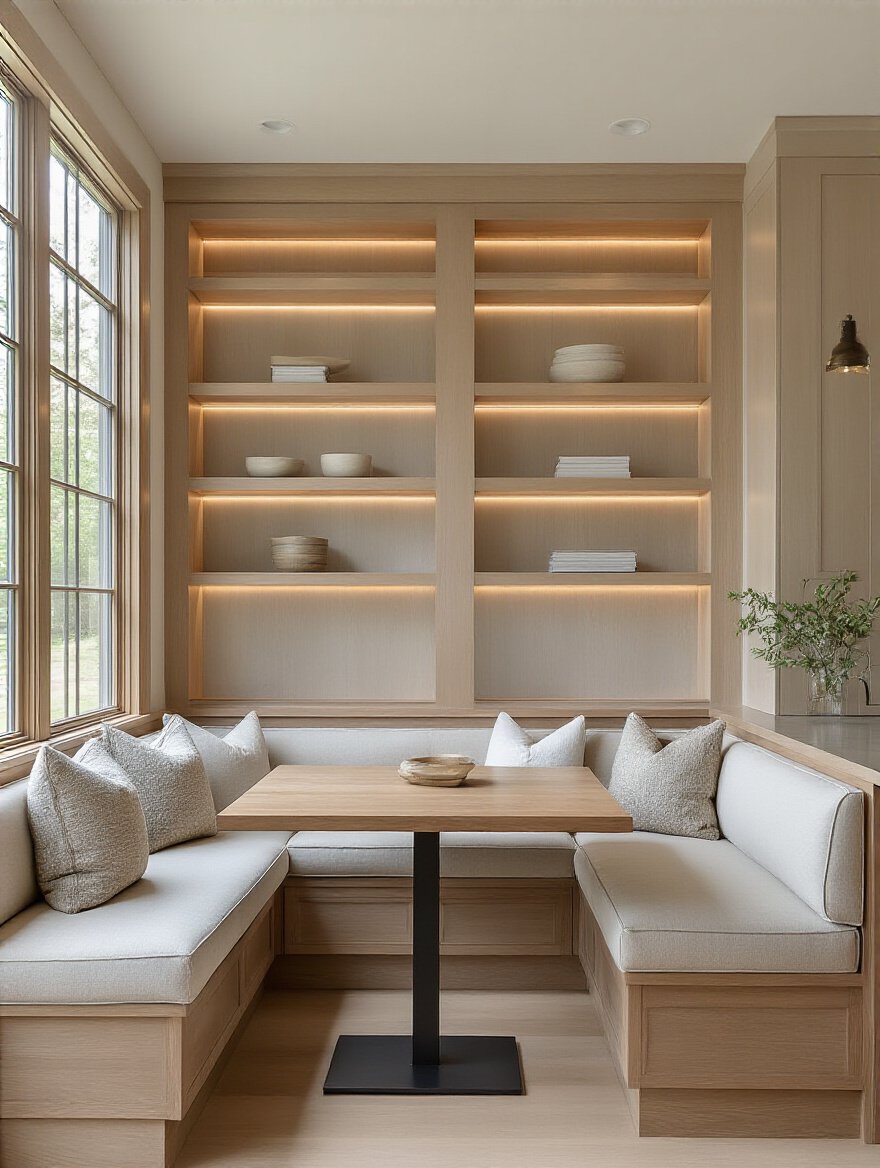
Imagine a beautiful L-shaped bench with plush cushions tucked into a corner. Not only does it seat more people in a smaller footprint, but you can build it with lift-up tops for hidden storage underneath. It’s brilliant! This is where you stash the holiday linens, the craft supplies, the board games. It makes your room work smarter, not harder.
And since we’re talking about storage, let’s make sure it’s a design statement.
10. Declutter Your Dining Room with Integrated, Hidden Storage
A beautiful buffet, credenza, or sideboard is the unsung hero of the dining room. It’s not just a surface to put a lamp on; it’s your storage command center. This is where you hide the beautiful chaos of hosting—the extra placemats, the serving dishes, the candle collection that’s gotten slightly out of hand.
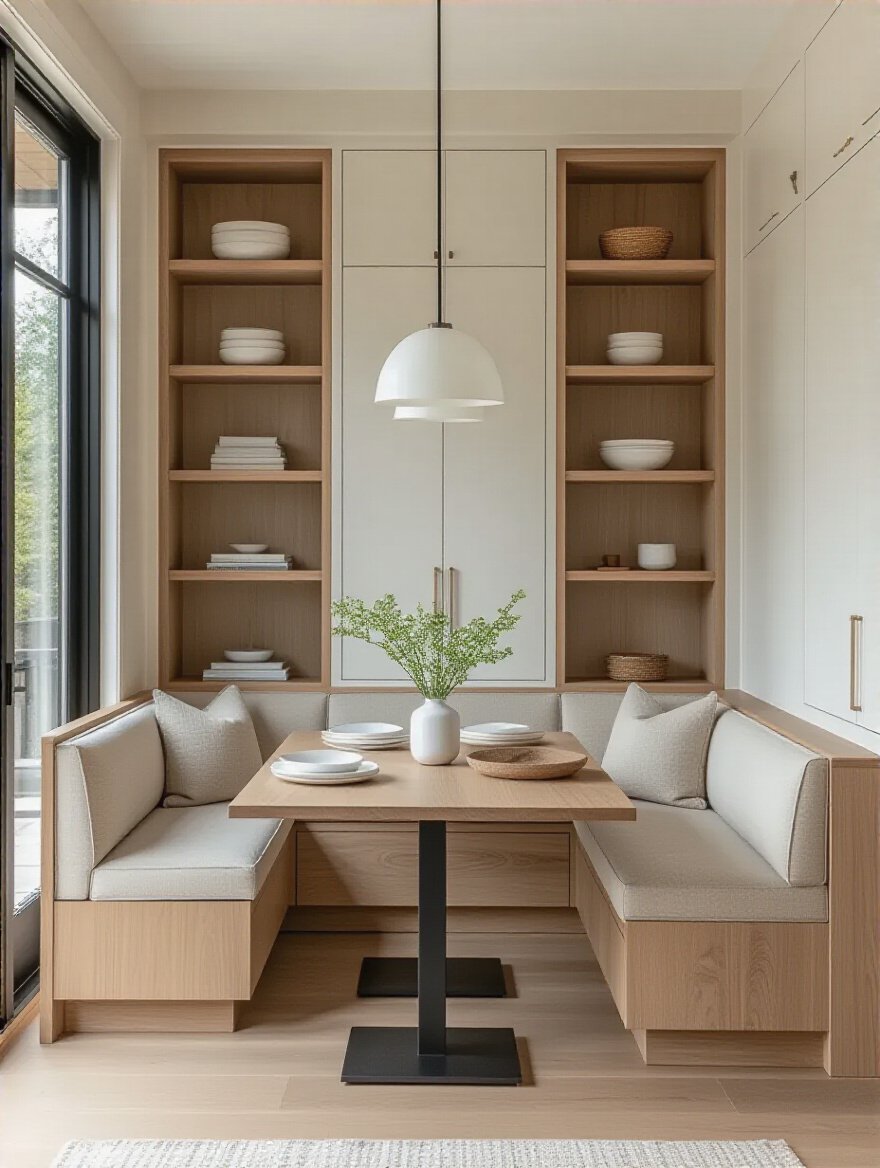
The key to that serene, uncluttered look is having a designated home for everything. When everything has a place, it takes five minutes to reset the room for the next day or the next season. Look for pieces with a mix of drawers and cabinets so you can organize everything perfectly, keeping the tabletop free for a simple, beautiful display.
And to finish off our functional layout, let’s revisit our favorite anchor.
11. Clearly Delineate Your Dining Area Using a Well-Placed Rug
Yes, we’re talking about the rug again! It’s that important. Especially in open-plan homes, the rug is the element that draws the boundary lines and makes your dining area feel cozy and self-contained. It’s like drawing a magic circle around your table.
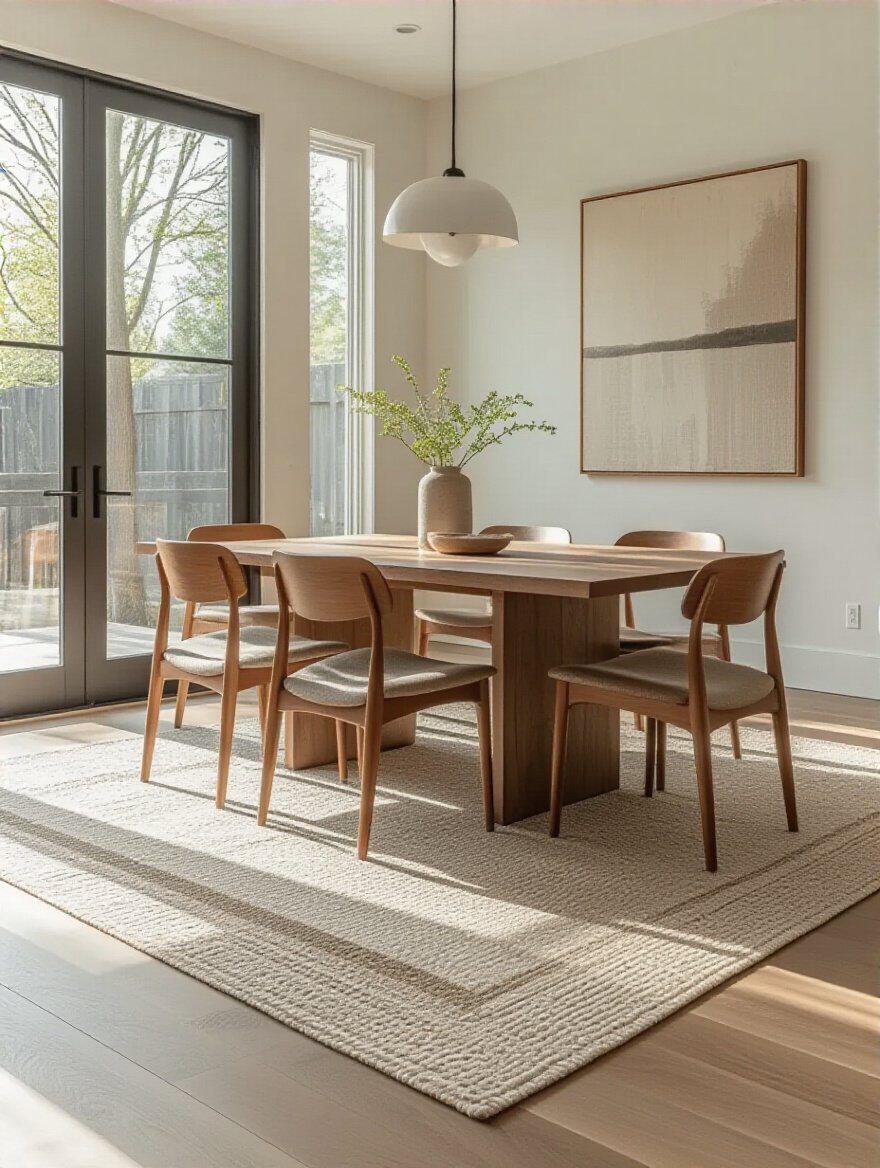
But here’s the shortcut you need to know, the number one thing people get wrong: size. Your rug needs to be big enough so that when you pull the chairs out to sit down, all four legs are still on the rug. All of them. If the back legs fall off the edge, the rug is too small. It will look awkward and be a tripping hazard. Measure your table, add about 24-30 inches on every side, and buy that size. No exceptions.
Crafting Atmosphere: Lighting, Art & Sensory Enhancements
The room is functional. The layout is smart. Now for the really fun part—let’s make it magical. This is where we play with lighting, art, and texture to create a mood that feels layered, personal, and absolutely enchanting. This is the sparkle.
12. Install a Striking Pendant Light to Anchor Your Table
A beautiful pendant light or chandelier is the jewelry of your dining room. It’s the exclamation point right over the table, the one thing that draws your eye up and makes the whole space feel finished and grand. Don’t be afraid to go a little bigger or bolder than you think you should. A dinky little light will get lost. A substantial, sculptural one becomes art.

This one fixture does so much heavy lifting. It physically anchors the table in the space, provides essential light for your meal, and sets the entire stylistic tone. I had a client with a very simple, minimalist dining set, and we installed a huge, dramatic, spidery black pendant light. It completely transformed the room from nice to wow in a single afternoon.
Of course, that one light can’t do all the work alone.
13. Create Warm Ambiance with Layered, Dimmable Lighting
If you listen to only one piece of my advice, let it be this: put everything on a dimmer switch. The pendant, the sconces, the recessed lights—all of it. This is my unbreakable event-planner rule. It is the cheapest, fastest, and most effective way to completely change the mood of a room.
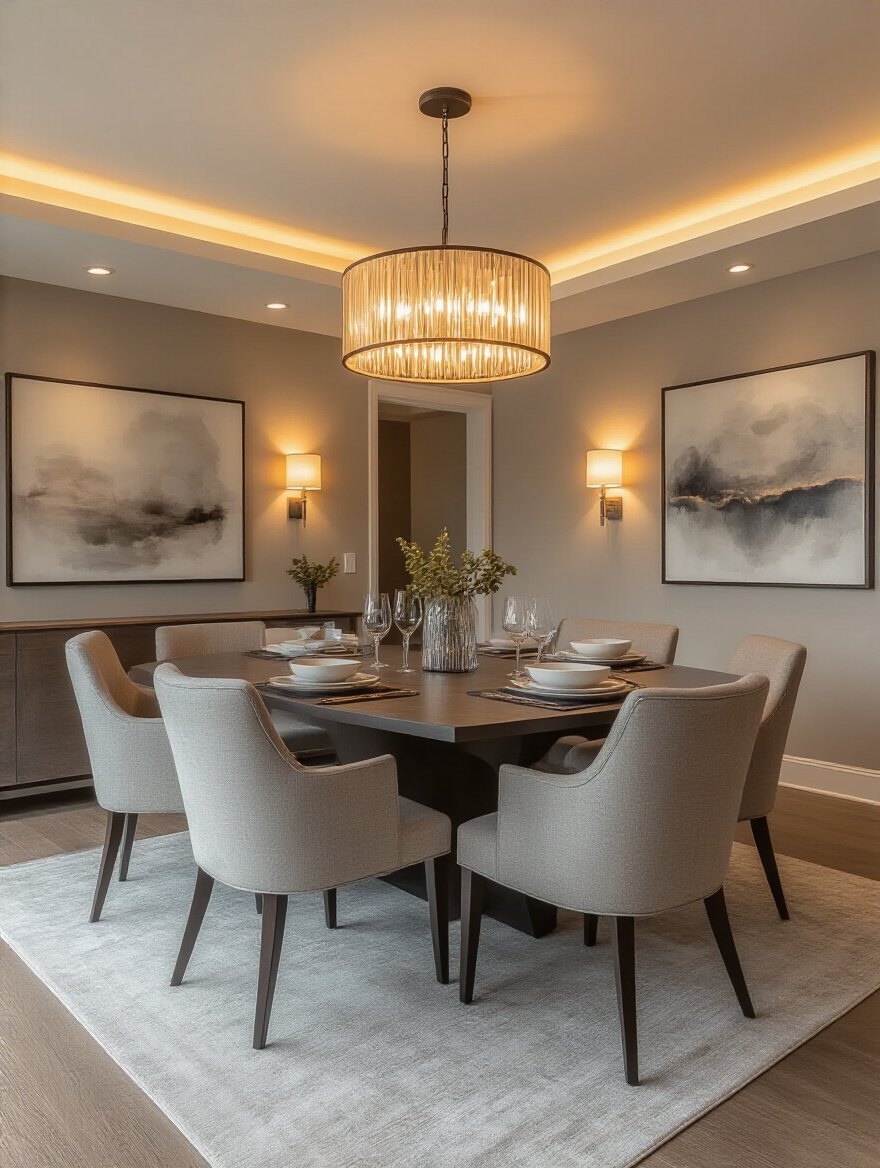
You need bright, clear light for cleaning up or for when the kids are doing a puzzle. But for dinner? You want that low, warm, flickering glow that makes everyone look beautiful and feel relaxed. Layering your light—having multiple sources you can control independently—gives you ultimate power over the atmosphere. It’s the difference between a cafeteria and a chic bistro.
Now that the lighting is perfect, let’s give it something beautiful to shine on.
14. Select a Bold Art Piece to Elevate Your Dining Room Style
Please, I’m begging you, step away from the generic, mass-produced “art” from the big box store. One single piece of meaningful art will do more for your dining room’s soul than a dozen bland canvases. It doesn’t have to be a ridiculously expensive painting from a fancy gallery, either. It just has to be something that speaks to you.
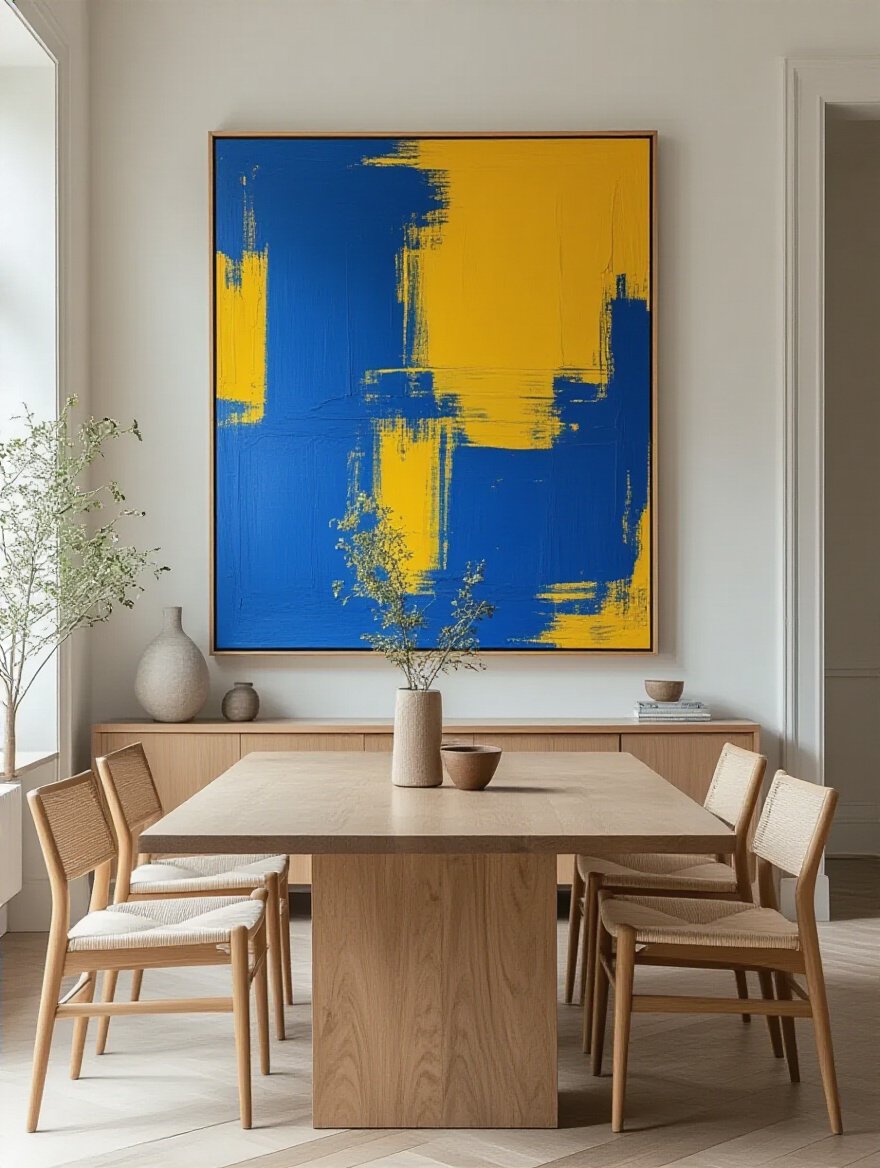
It could be a massive, beautifully framed photograph you took on a trip. It could be an edgy abstract from a local art student. It could be a vintage textile you found at a flea market. When you choose art you love, it infuses the space with your personality and becomes an instant conversation starter for your guests.
To give that art an even more powerful backdrop, let’s dress up the wall itself.
15. Design an Architectural Feature Wall for Visual Impact
This is another one of those terms that sounds more intimidating than it is. An “architectural feature wall” can be as simple as a gorgeous, dramatic wallpaper on the wall behind your buffet. It could be an easy weekend DIY project like board and batten. Or it could be just painting one wall a deep, saturated color that’s different from the rest.
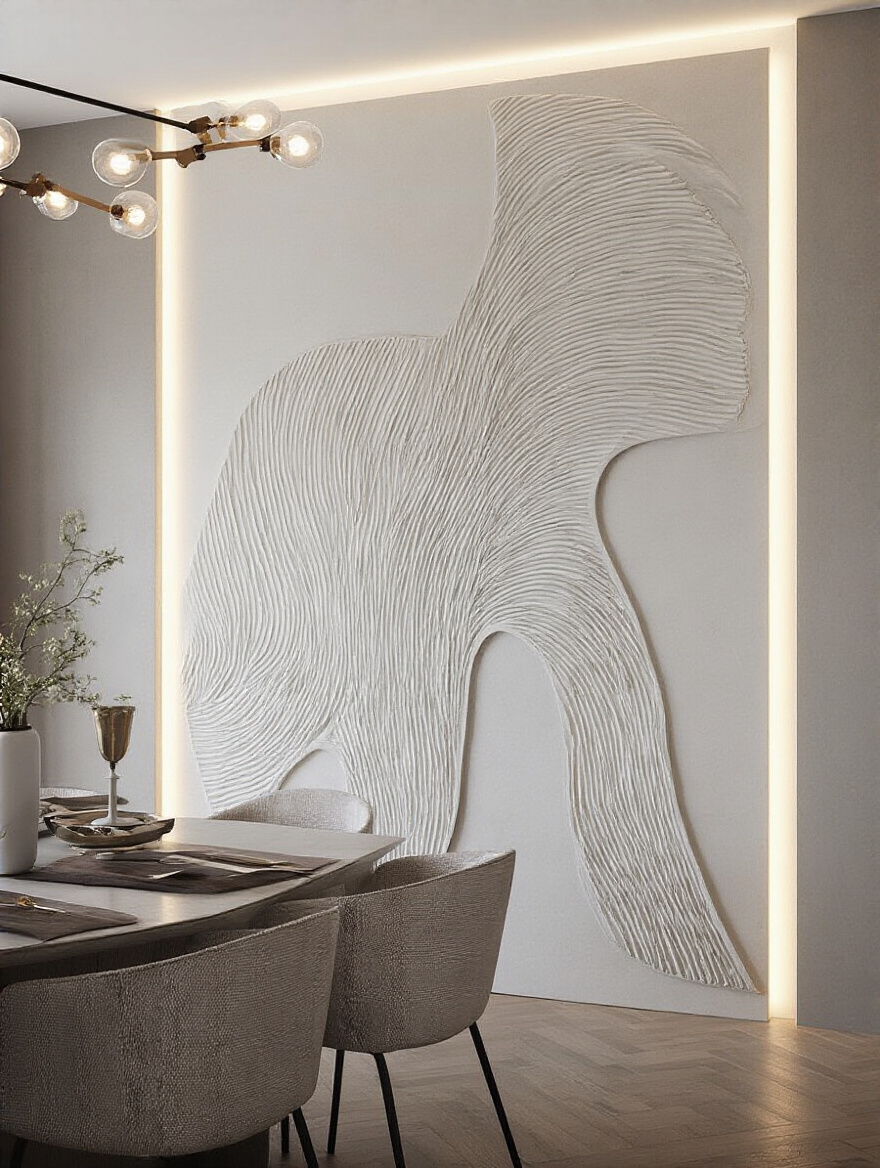
Creating a feature wall adds instant depth and drama to the room. It’s an amazing way to create a focal point without adding more clutter. I especially love doing this on the main wall you see when you walk into the room. It makes such a confident, stylish statement and provides the perfect stage for your beautiful art or a chic console table.
And if you want to add drama and make your room feel bigger?
16. Utilize Mirrors or Glass to Amplify Space and Light
This is an old-school designer trick for a reason: it works every single time. A large mirror is a magic wand for a small or dark dining room. Hang it on the wall opposite a window, and it will bounce natural light all over the space, making it feel brighter and so much more expansive. It’s like adding a new window for a fraction of the cost.

I especially love a big mirror in a dining room because it reflects the glow of your pendant light and the flicker of candlelight during a dinner party. It doubles the sparkle and the ambiance, creating a layered, magical effect. A simple, large, floor-to-ceiling mirror can visually erase a wall, making the room feel twice its size.
Finally, let’s engage the sense of touch.
17. Add Depth and Warmth by Blending Diverse Textures
This is the secret to making a modern or minimalist room feel cozy and inviting, not cold and sterile. Think about a sensory feast. You want to layer different textures that appeal to both the eye and the hand. The smoothness of ceramic plates, the slight roughness of a linen tablecloth, the softness of a wool rug underfoot, the coolness of a metal candlestick.

This is what gives a room depth and dimension. Contrast is your friend here. Pair a sleek, glossy table with soft, velvety upholstered chairs. Lay a nubby, natural fiber jute rug on a smooth hardwood floor. It’s this rich mix of materials that makes a room feel curated, thoughtful, and deeply comfortable.
Refined Details & Smart Integration: Elevating Modern Dining
We’re in the home stretch! The foundation is solid, the atmosphere is magical. These are the final, thoughtful layers that will make your dining room feel completely finished, wonderfully personal, and truly alive.
18. Infuse Nature with Strategic Greenery and Plant Displays
Every single room needs something living in it. Full stop. Plants are the quickest way to breathe life, color, and sculptural beauty into your dining room. A towering fiddle leaf fig in a corner can add drama and height, while a simple vase of eucalyptus or olive branches on the table adds an touch of effortless, organic elegance.
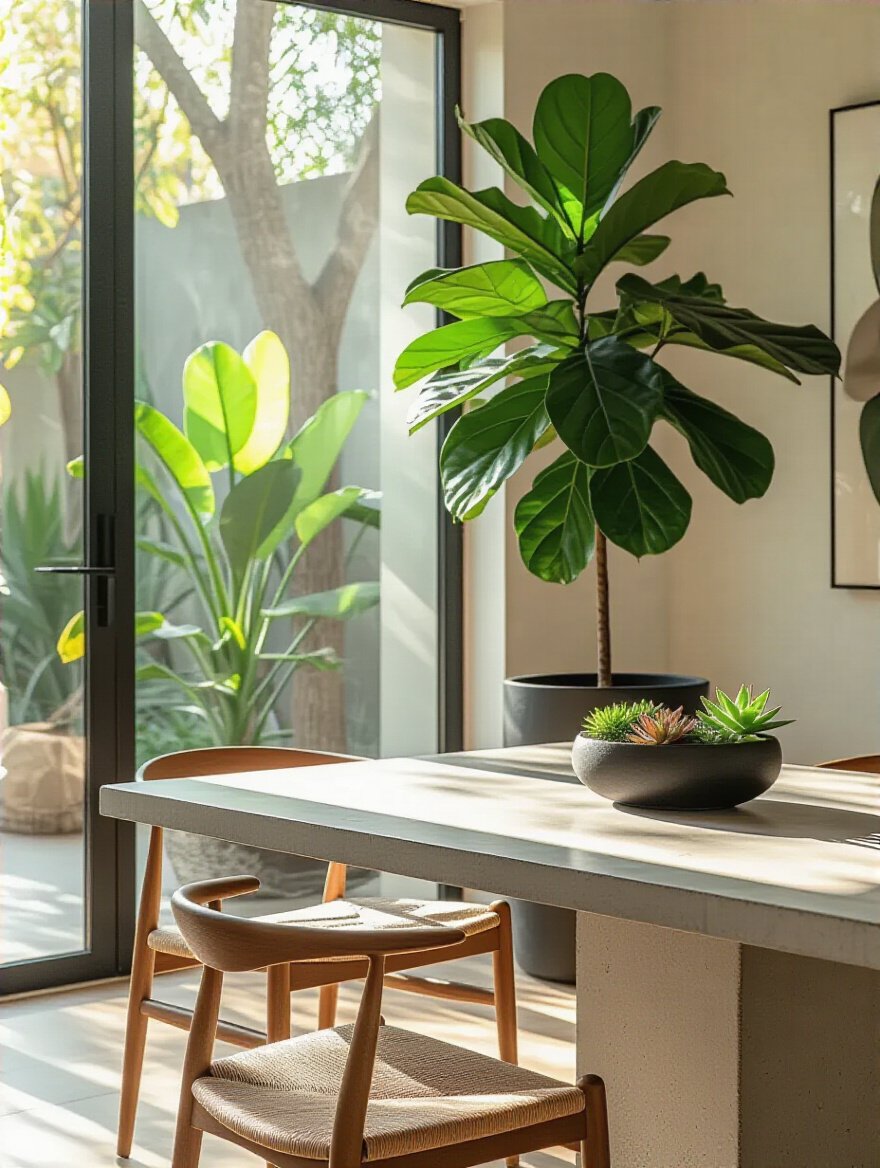
You don’t need to create a jungle. The key is to be strategic. A few well-placed plants are more impactful than a dozen tiny ones cluttering up the space. Greenery softens the hard lines of furniture and architecture and provides a pop of color that, by its very nature, is always in style. It’s the perfect finishing touch.
To make hosting even more effortless, let’s talk tech.
19. Seamlessly Integrate Smart Tech for Modern Convenience
I’m not talking about turning your dining room into the control deck of a spaceship. I’m talking about smart tech that is felt, not seen. Technology that works quietly in the background to make your life easier and your parties better. The best modern design is intuitive.
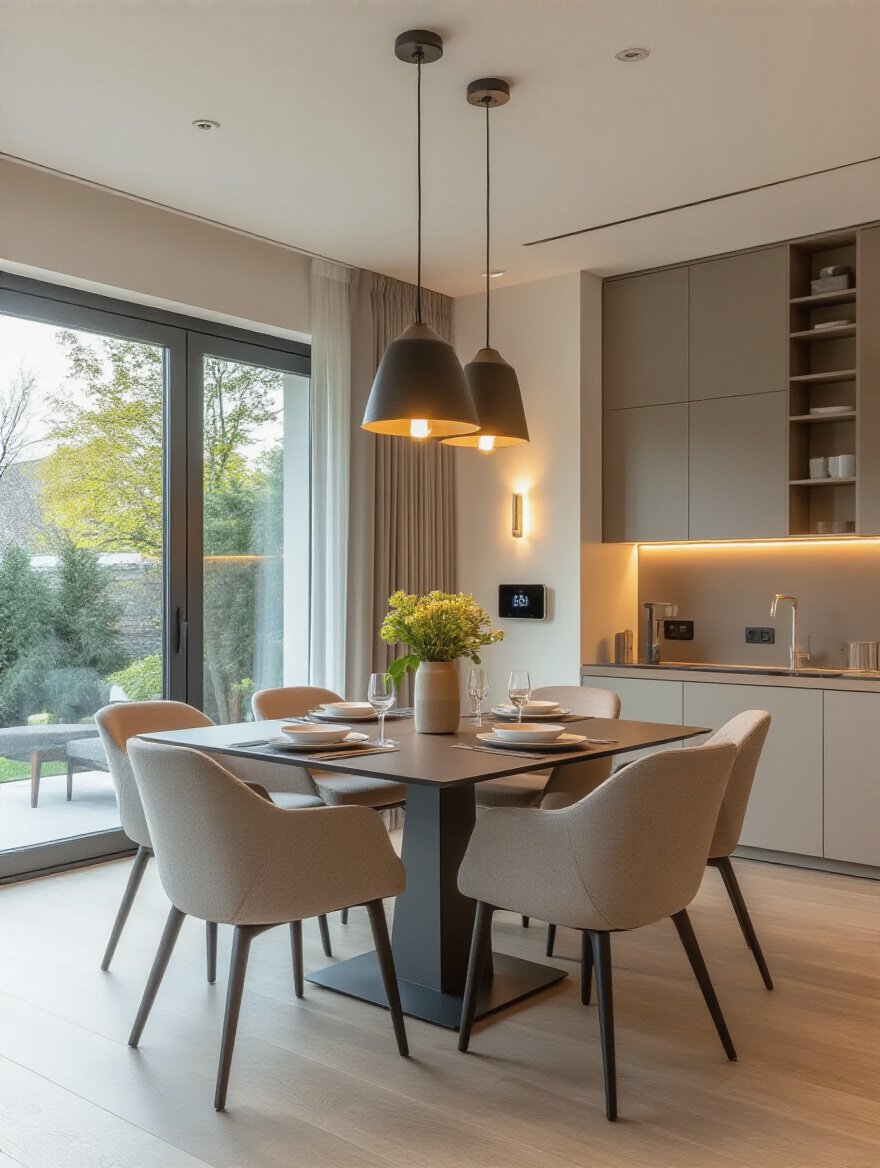
Imagine this: You’re finishing up in the kitchen, and you say, “Alexa, set the dinner party scene.” Instantly, the lights dim to that perfect warm glow, your favorite chill dinner playlist starts streaming from discreet ceiling speakers, and the smart blinds lower slightly for privacy. That’s not science fiction; that’s just effortless hosting.
Let’s also think about connecting with nature on a grander scale.
20. Connect Dining Space with Nature through Large Openings
If you’re renovating or building, this is a total game-changer. Swapping a standard window or door for expansive sliding or bifold glass doors can completely transform your dining experience. It erases the boundary between your indoor space and your garden or patio, making the room feel endless.
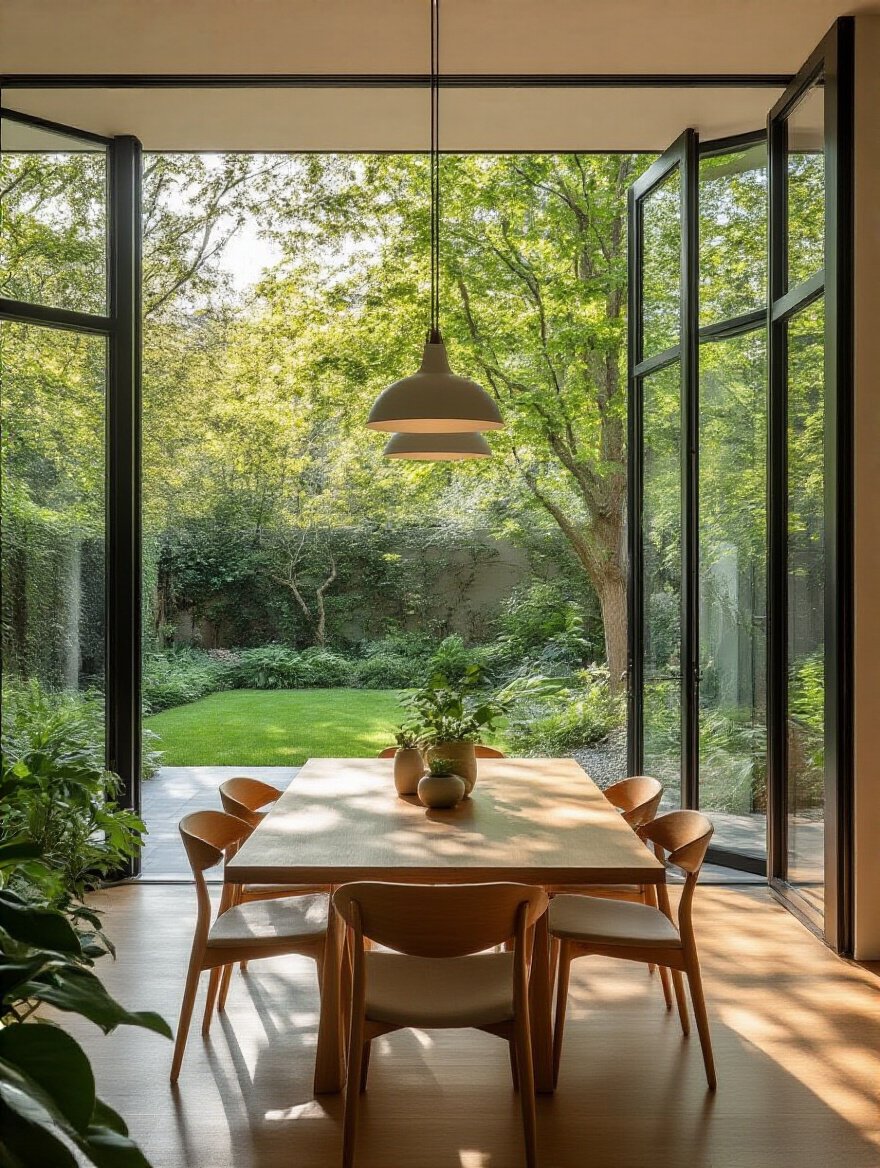
On a beautiful summer evening, you can slide those doors wide open and let the breeze flow through, effectively doubling your entertaining space. It floods the room with natural light, which saves energy and just makes everyone feel happier. This is the ultimate way to bring the beauty of the outdoors in.
With a seamless flow to the outdoors, let’s make sure the indoors screams you.
21. Curate Unique Decor to Reflect Your Personal Style
Your home should tell your story. So, look around your dining room. Does it look like a page from a catalog, or does it look like you live there? This final layer is all about infusing the space with your unique personality. Get those souvenirs from your travels out of a drawer and put them on display!
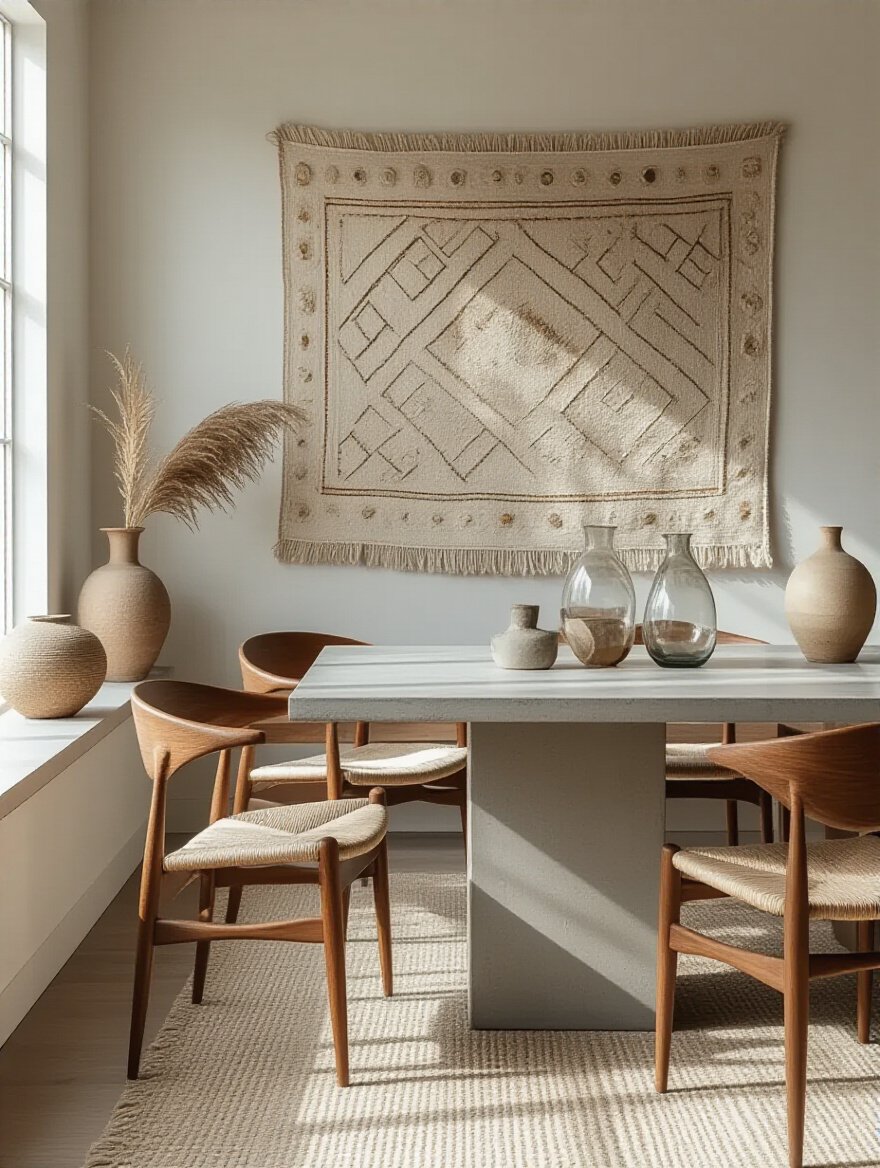
Frame that funny old family photo. Show off the weird, wonderful pottery you found at a thrift store. Mix the sleek new chairs with your grandmother’s vintage buffet. It’s this personal, quirky mix that keeps a modern room from feeling sterile. Don’t be afraid to be yourself; that’s what turns a house into a home.
And for the final, crucial touch…
22. Improve Comfort and Conversation with Acoustic Considerations
Have you ever been in a gorgeous restaurant that’s so loud and echoey you have to shout to hear the person across the table? It’s awful. Don’t let your dining room be that place. With all the hard surfaces in modern design—wood floors, glass, stone tabletops—sound can bounce around like crazy.
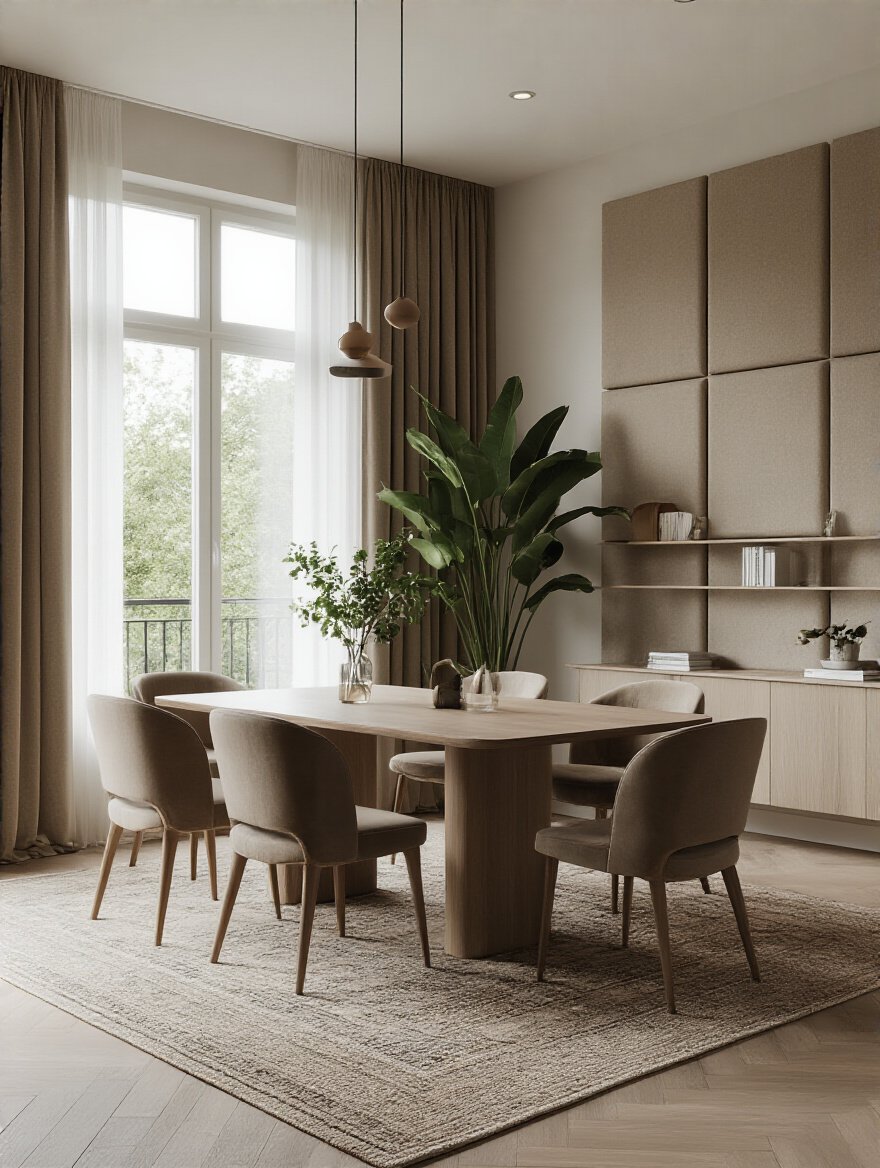
This is where all our previous work comes to the rescue. That big area rug? It absorbs sound. Those plush upholstered chairs? They soak it up. Curtains, art, even a large plant—they all help to diffuse sound waves, making the room quieter and conversation easier. Good acoustics are an invisible luxury that makes a massive difference in how comfortable your space feels.
A Room for Real Life
Creating a modern dining room isn’t about following a rigid set of rules; it’s about crafting a space that is beautiful, functional, and a true reflection of you. It’s an adaptable stage for life’s moments—big and small. Think of these ideas as a creative toolkit. You don’t have to do them all at once! Maybe you start by finding that perfect rug, or finally installing that dimmer switch you’ve been meaning to get to.
Your dining room is waiting to become the most loved and lived-in room in your house. It’s ready for the messy, beautiful, chaotic, and joyful reality of your life. So, go on. Design a space that inspires connection, a place that makes you want to pull up a chair and stay a while.
